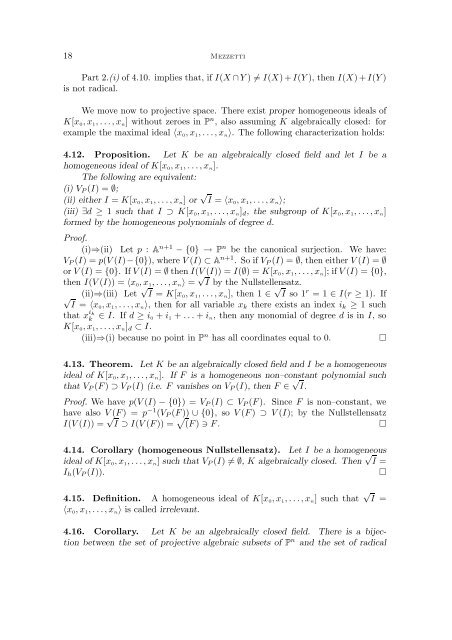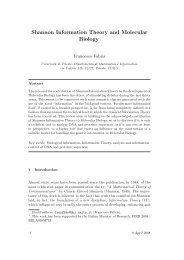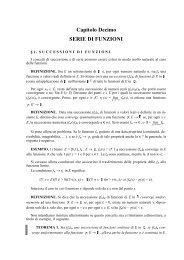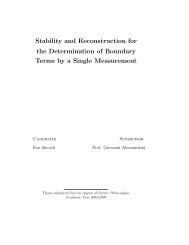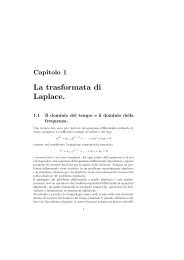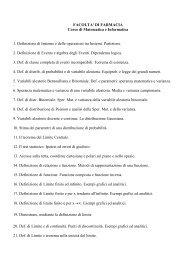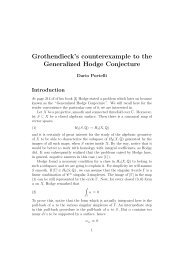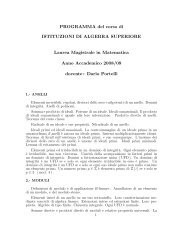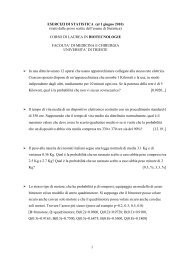INTRODUCTION TO ALGEBRAIC GEOMETRY Note del corso di ...
INTRODUCTION TO ALGEBRAIC GEOMETRY Note del corso di ...
INTRODUCTION TO ALGEBRAIC GEOMETRY Note del corso di ...
Create successful ePaper yourself
Turn your PDF publications into a flip-book with our unique Google optimized e-Paper software.
18 MezzettiPart 2.(i) of 4.10. implies that, if I(X ∩Y ) ≠ I(X)+I(Y ), then I(X)+I(Y )is not ra<strong>di</strong>cal.We move now to projective space. There exist proper homogeneous ideals ofK[x 0 , x 1 , . . ., x n ] without zeroes in P n , also assuming K algebraically closed: forexample the maximal ideal 〈x 0 , x 1 , . . ., x n 〉. The following characterization holds:4.12. Proposition. Let K be an algebraically closed field and let I be ahomogeneous ideal of K[x 0 , x 1 , . . ., x n ].The following are equivalent:(i) V P (I) = ∅;(ii) either I = K[x 0 , x 1 , . . ., x n ] or √ I = 〈x 0 , x 1 , . . ., x n 〉;(iii) ∃d ≥ 1 such that I ⊃ K[x 0 , x 1 , . . ., x n ] d , the subgroup of K[x 0 , x 1 , . . ., x n ]formed by the homogeneous polynomials of degree d.Proof.(i)⇒(ii) Let p : A n+1 − {0} → P n be the canonical surjection. We have:V P (I) = p(V (I)−{0}), where V (I) ⊂ A n+1 . So if V P (I) = ∅, then either V (I) = ∅or V (I) = {0}. If V (I) = ∅ then I(V (I)) = I(∅) = K[x 0 , x 1 , . . ., x n ]; if V (I) = {0},then I(V (I)) = 〈x 0 , x 1 , . . ., x n 〉 = √ I by the Nullstellensatz.(ii)⇒(iii) Let √ I = K[x 0 , x 1 , . . ., x n ], then 1 ∈ √ I so 1 r = 1 ∈ I(r ≥ 1). If√I = 〈x0 , x 1 , . . ., x n 〉, then for all variable x k there exists an index i k ≥ 1 suchthat x i kk∈ I. If d ≥ i 0 + i 1 + . . . + i n , then any monomial of degree d is in I, soK[x 0 , x 1 , . . ., x n ] d ⊂ I.(iii)⇒(i) because no point in P n has all coor<strong>di</strong>nates equal to 0.□4.13. Theorem. Let K be an algebraically closed field and I be a homogeneousideal of K[x 0 , x 1 , . . ., x n ]. If F is a homogeneous non–constant polynomial suchthat V P (F) ⊃ V P (I) (i.e. F vanishes on V P (I), then F ∈ √ I.Proof. We have p(V (I) − {0}) = V P (I) ⊂ V P (F). Since F is non–constant, wehave also V (F) = p −1 (V P (F)) ∪ {0}, so V (F) ⊃ V (I); by the NullstellensatzI(V (I)) = √ I ⊃ I(V (F)) = √ (F) ∋ F.□4.14. Corollary (homogeneous Nullstellensatz). Let I be a homogeneousideal of K[x 0 , x 1 , . . ., x n ] such that V P (I) ≠ ∅, K algebraically closed. Then √ I =I h (V P (I)).□4.15. Definition. A homogeneous ideal of K[x 0 , x 1 , . . ., x n ] such that √ I =〈x 0 , x 1 , . . ., x n 〉 is called irrelevant.4.16. Corollary. Let K be an algebraically closed field. There is a bijectionbetween the set of projective algebraic subsets of P n and the set of ra<strong>di</strong>cal


